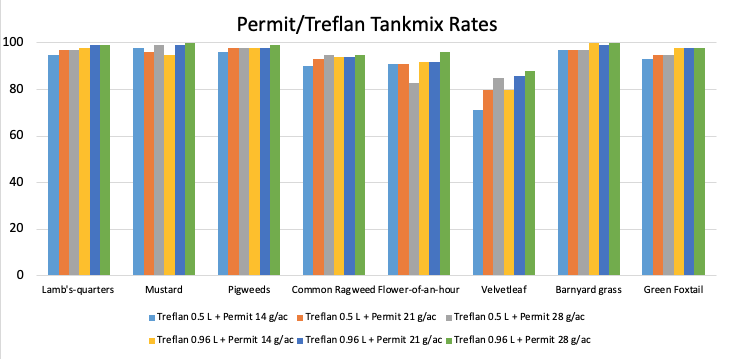Introduction
Determining the best weed control program for white bean producers can be challenging. Weed pressure, weed species composition, herbicide application timing, application rate and, of course, cost are all factors to consider. There are a number of products available to growers that provide differing levels of control across a range of weed species.
Background
In recent years, numerous studies have been completed on Permit applied pre-plant incorporated either alone or in tank-mix combination with soil applied grass herbicides. Permit has excellent crop tolerance in dry beans and works well with all of the soil applied grass herbicide options available in Ontario. Much of this work was conducted with Permit applied at 21 g/ac and generally the lowest label rate of the grass herbicide. The tank-mix combination of Permit plus Treflan provides broad-spectrum annual grass and broadleaf weed control. The Permit label has a rate range of 14 to 28 g/ac, and Treflan has a rate range of 0.5 to 0.96 l/ac. Very little work has been done looking at the effect of rate with Treflan + Permit applied in combination.
Evaluations
Six weed control trials were conducted over a three year period (2016-2018) at the Huron Research Station and Ridgetown Campus to determine the effect of Treflan and Permit rate on weed control, white bean yield and net returns. Permit was applied at three different rates (14, 21 and 28 g/ac) with Treflan at either 0.5 L/ac or 0.96 L/ac. Individual treatments of Permit and Treflan applied alone at the same rates were also evaluated. Treatments were compared to a weedy and weed-free control. Treatments were applied pre-plant incorporated prior to seeding. Weeds evaluated in these studies were: Lambsquarters, Wild Mustard, Pigweeds, Common Ragweed, Flower-of-an-hour, Velvetleaf, Barnyard Grass and Green Foxtail.
Results
Treflan at both rates provided excellent control of lambsquarters and both grass weed species evaluated, good control of pigweeds and poor control of the remaining broadleaf weed species. Permit alone, across rates, provided excellent control of wild mustard and pigweeds, good control of lambsquarters, common ragweed, and velvetleaf, fair to good control of flower-of-an-hour and poor control of the grass weed species evaluated. The tank-mix of Permit plus Treflan across all rates provided excellent control of lambsquarters, wild mustard, pigweeds, common ragweed, flower-of-an-hour, barnyard grass and green foxtail and good control of velvetleaf. As the rate of Permit, alone or in tank-mix combination with Treflan, was increased the level of velvetleaf control improved. Control of common ragweed increased as the rate of Permit increased when tank-mixed with Treflan at the low rate. (See Figure 1.) At the high rate of Treflan there was no need to increase the rate of Permit. For the remainder of the species evaluated there was excellent control with the low rates of both Permit and Treflan. Crop yield with all tank-mix combinations was equivalent to the weed-free control.

Conclusions
Growers can benefit from making rate adjustments when using a tank-mix of Permit plus Treflan for weed control in dry beans. Rate adjustments should be made according to records of weed species present in each field. This information will allow growers to increase profitability by reducing input costs based on weed species composition. The ability to reduce tank-mix rates, based on the information here, will help to reduce environmental loading with these herbicides.
This article was written by Todd Cowan and Peter Sikkema.